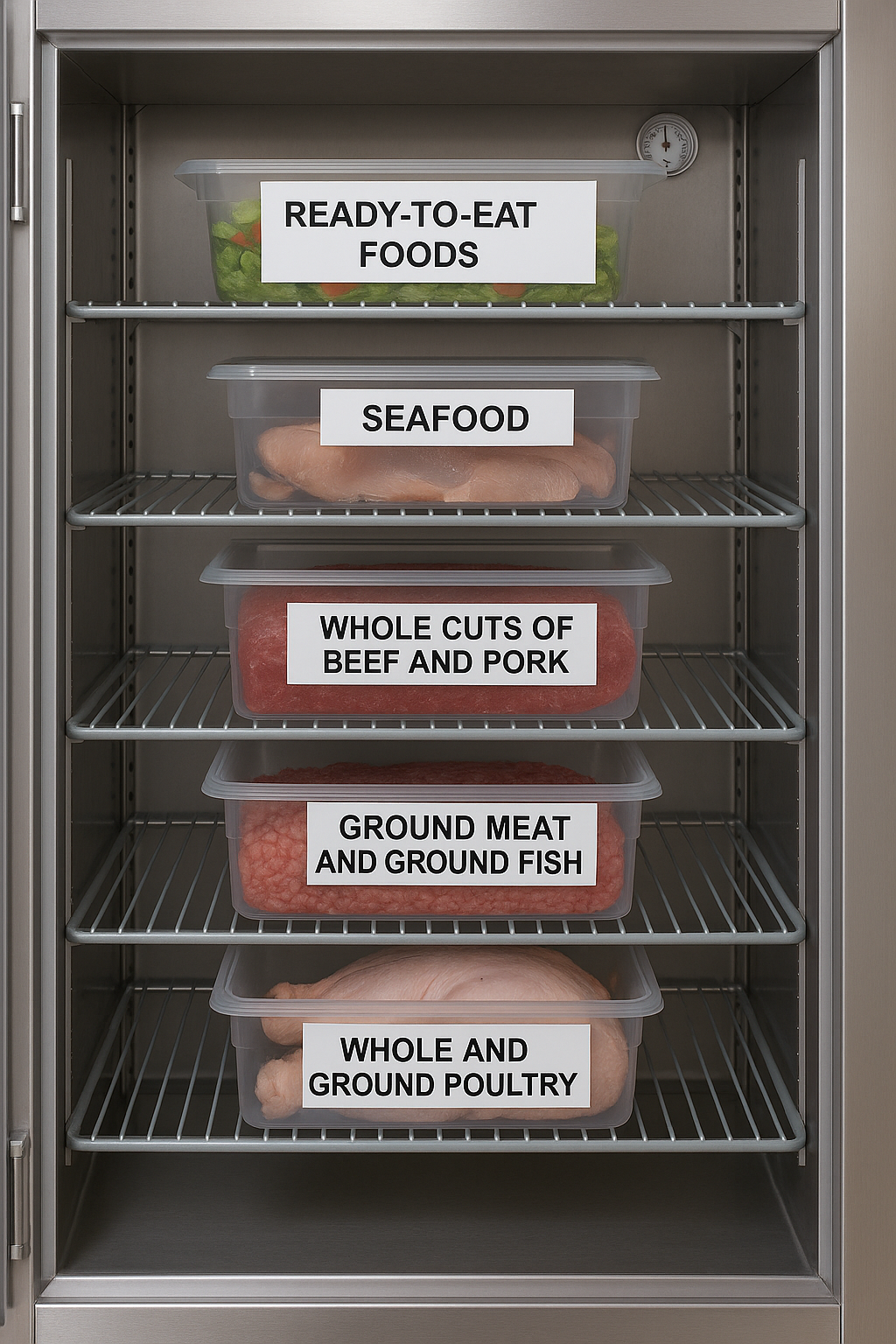39 7.2: Refrigerated Storage
7.2 Refrigerated Storage
What is Refrigerated Storage?
Refrigerated storage is the storage of food at low temperatures to suppress the growth of pathogenic microorganisms. It prevents food poisoning and extends the shelf life of food.
Most kitchens use a walk-in cooler for their primary refrigerated storage area. Foods requiring time/temperature control for safety (TCS) food are required to be held at 41℉ (5℃) or below.

“Walk in cooler at work CLEAN” by Txspiked is licensed under CC BY-NC-ND 2.0. To view a copy of this license, visit https://creativecommons.org/licenses/by-nc-nd/2.0/?ref=openverse.
The walk-in cooler is a large enclosed area built like a bank vault. The walls, floor, and ceiling are made from thick solid steel and contain insulation. All surfaces are constructed with easy-to-clean plastic or metal. The walk-in has its own cooling unit, similar to a residential refrigerator, but much more powerful for commercial use. There is also shatter-proof and/or covered lighting in the walk-in cooler, along with a temperature measurement system that allows for easy monitoring of the internal ambient air temperature and humidity without opening the door. Temperatures displayed on the monitoring system must be accurate within +/- 3℉ (+/-1.5℃). Newer models may connect to WiFi and automatically record temperature logs.
Refrigerated foods should be regularly checked and logged. Corrective action should be taken when required. TCS foods should be held away from the cooler door to diminish potential temperature abuse, as the cooler may be frequently opened and closed in an operation on a busy day.
Why Is It Important?
Certain foods, particularly those with a Time/Temperature Control for Safety (TCS) designation, need to be refrigerated because they are more susceptible to developing unsafe bacteria when stored at unsafe temperatures. They are dairy products, meats, cooked vegetables, cut fruits, and prepared salads

(Source: USDA.gov)
Safe Refrigerator Temperature Procedures
Keep refrigerators at 41°F (5°C) or below.
Use a thermometer within the unit to monitor the temperature.
Record the temperature at least once every shift.
One of the most effective methods of preventing bacterial growth is to keep food outside the temperature danger zone (41°F to 135°F).
General Requirements for Refrigerated Storage
Label and Date All Foods
Every food item should be marked with its name and the date it was stored.
Always use FIFO (First In, First Out)
Rotate stock so that the older items are used first. Put new items behind the older items.
Wrap and Cover Foods Properly
Keep food in covered containers or wrap food tightly to avoid cross-contamination.
Keep Raw Foods Below Ready-to-Eat Foods
Raw meat, poultry, and fish should be placed on lower shelves to prevent juices from spilling onto other foods.
Do Not Overstock the Refrigerator
Air must circulate to maintain appropriate temperatures inside the unit.
Clean Refrigerators Regularly
This keeps spills from building up and helps prevent mold, which could contaminate food.
Recommended Storage Order (Top to Bottom)
To reduce cross-contamination, store food like this:
Ready-to-eat foods (top shelf)
Seafood
Whole cuts of beef and pork
Ground meat and ground fish
Whole and ground poultry (bottom shelf)

(Source: ChatGPT)
This order is based on the minimum internal cooking temperatures necessary to kill pathogens in each food.
Fun Fact:
Did you know that refrigerators were introduced for home use in the early 1900s? Previously, people used iceboxes to store food. Contemporary refrigeration assists in minimizing food waste and provides safe storage of perishable foods.

“The fridge and the icebox” by litlnemo is licensed under CC BY-NC-SA 2.0. To view a copy of this license, visit https://creativecommons.org/licenses/by-nc-sa/2.0/?ref=openverse.
Quick Review
Store cold food at 41°F or below.
Date and label all food in storage.
Store raw meat below ready-to-eat foods.
Clean and check temperatures every day.
